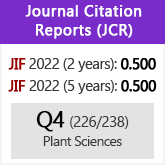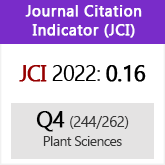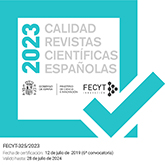Molecular systematics of the genera Laurencia, Osmundea and Palisada (Rhodophyta) from the Canary Islands - Analysis of rDNA and RUBISCO spacer sequences
DOI:
https://doi.org/10.3989/ajbm.2008.v65.i1.248Keywords:
Laurencia, Osmundea, Palisada, Phylogeny, Canary IslandsAbstract
The molecular systematics of Laurencia, Osmundea and Palisada (Rhodomelaceae, Ceramiales) species from the Canary Islands has been determined by analysis sequences of the ribulose,1-5, bisphosphate carboxylase (RUBISCO) spacer from the plastid genome and the internal transcribed spacers (ITS1 and ITS2) and the rDNA 5.8S coding region from the nuclear genome. Comparison of sequence data showed an identity of 72-83 % between the species. Three taxonomic group were identified that correspond to established phylogenetic taxons. Phylogenetic trees using both parsimony and maximum-likelihood methods were derived from the sequence data; the trees indicate that O. pinnatifida appears to be the most distantly related species from the Laurencia and Palisada species. The exact phylogenetic position of Laurencia sp. A (“amarilla”) need additional studies.
Downloads
References
Assali N., Martin W., Sommerville & Loiseaux-de Goer S. 1991. Evolution of the Rubisco operon from prokaryotes to algae. Structure and analysis of the RbcS gene of the brown algae Pylaeilla littoralis. Plant Molecular Biology 17: 853-863. doi:10.1007/BF00037066
Bakker, F., Olsen, J. & Stam, W. 1995. Evolution of Nuclear rDNA ITS sequences in the Cladophora albida/sericea Clade (Chlorophyta). Journal of Molecular Evolution 40: 640-651. doi:10.1007/BF00160512
Baldwin, B. 1992. Phylogenetic utility of the internal transcribed spacers for nuclear ribosomal DNA in plants: an example from the Compositae. Molecular Phylogenetics and Evolution 1: 3-16. doi:10.1016/1055-7903(92)90030-K
Beauchamp, K. & Powers, D. 1996. Sequence variation of the first internal spacer (ITS-1) of ribosomal DNA in ahermatypic corals from California. Molecular marine biology and biotechnology 5: 357-362.
Cassano, V., M.T. M. Szechy & M.T. Fujii. 2006. Laurencia caduciramulosa (Ceramiales, Rhodophyta) from Ilha Grande Bay, Rio de Janeiro, Brazil: a recent introduction into the Atlantic Ocean? Cryptogamie, Algologie 27(3): 265-277.
Coleman, A., Suarez, A. & Goff, L. 1994. Molecular delineation of species and syngens in Volvocacean green algae (Chlorophyta). Journal of Phycology 30: 80-90. doi:10.1111/j.0022-3646.1994.00080.x
Cordeiro-Marino, M., Toyota Fuji, M. & Yamaguishi-Tomita, N. 1983. Morphological and Cytological studies on Brazilian Laurencia. 1: L. arbuscula Sonder (Rhodomelaceae, Rhodophyta). Rickia 10: 29-39.
Cribb, A.B. 1983. Marine Algae of the Southern Great Barrier Reef. Part l. Rhodophyta. Australian Coral Reef Society, Brisbane, Handbook No. 2. 173 pp, 71 pls.
Delaney, T. & Cattolico, R. 1989. Chloroplast ribosomal DNA organization in the chromophytic algae Olisthodiscus luteus. Current Genetics 15(3): 221-229. doi:10.1007/BF00435509
Destombe, C. & Douglas, S. 1991. Rubisco spacer sequence divergence in the rhodophyta algae Gracilaria verrucosa and closely related species. Current Genetics 19: 395-398. doi:10.1007/BF00309601
Diaz-Piferrer M. 1970. Adiciones a la flora marina de Venezuela. Caribbean Journal of Science 10(3-4): 159-198.
Douglas, S. & Durnford, D. 1989. The small subunit of ribulose- 1,5-bisphosphate carboxylase is plastid encoded in the chlorophyll c-containing algae Cryptomonas. Plant Molecular Biology 13: 13-20. doi:10.1007/BF00027331
Druehl, L. & Saunders, G. 1992. Molecular explorations in kelp evolution. In: Round, F.E. & Chapman, D.J. (eds), Progress in Phycological Research Vol. 8. Dan Hua Printing Press Co. Ltd, Hong Kong, pp. 47-78
Furnari, G, Boissett, F, Cormaci, M & Serio, D. 2002. Characterization of Chondrophycus tenerrimus (Cremades) comb. nov. (Ceramiales, Rhodophyta), a species often misidentified as C. papillosus (C. Agardh) Garbary & J. Harper in the Mediterranean Sea. Cryptogamie, Algologie 23: 223-235.
Furnari, G., Cormaci, M. & Serio, D. 2001. The Laurencia complex (Rhodophyta, Rhodomelaceae) in the Mediterranean Sea: an overview. Cryptogamie, Algologie 22: 331-373. doi:10.1016/S0181-1568(01)01065-0
Garbary, D.J & Harper, J.T. 1998. A phylogenetic analysis of the Laurencia complex (Rhodomelaceae) of the red algae. Cryptogamie Algology 19(3): 185-200.
Gil-Rodríguez, M.C. & Haroun, R. 1992. Laurencia viridis sp nov. from the macaronesia Region. Botanica Marina 35(3): 227-237.
Gil-Rodríguez, M.C. & Haroun, R. 1993. A view about the problematic in Laurencia (Rhodomelaceae, Rhodophyta) in the Canary Islands. Courier Forschungsinstitut Senckenberg 159: 113- 117.
Goff, L., Moon, D. & Coleman, A. 1994. Molecular delineation of species and species relationships in the red algal agarophytes Gracilariopsis and Gracilaria (Graciariales). Journal of Phycology 30: 521-537. doi:10.1111/j.0022-3646.1994.00521.x
Haroun, R. & Prud’homme van Reine, W. 1993. A biogeographical study of Laurencia and Hypnea species of the Macaronesian Region. Courier Forschungsinstitut Senckenberg 159: 119-125.
Hernández-González, M.C., Gil-Rodríguez, M.C. & Haroun, R. 1994. Existence of plants bearing tetrasporangia and spermatangial receptacles (mixed phases) in the genus Laurencia Lamouroux (Rhodomelaceae). Nova Hedwigia 59: 189-194.
Hommersand, M., Fredericq, S. & Freshwater, D. 1994. Phylogenetic systematics and biogeography of the Gigatinaceae (Gigartinales, Rhodophyta) based on sequence analysis of rbcL. Botanica Marina 37: 193-203.
Klein, J. & Verlaque, M. 2005. Laurencia caduciramulosa Masuda et Kawaguchi (Ceramiales, Rhodophyta), first record on the Mediterranean coast of France. Cryptogamie, Algologie 26: 209- 216.
Kono, M., Satoh, H., Okabe, Y., Abe, Y., Nakayama, K. & Okada, M. 1991. Nucleotide sequence of the large subunit of Ribulose -1, 5- bisphosphate carboxylase / oxygenase from the green algae Bryopsis maxima. Plant Molecular Biology 17: 505-508. doi:10.1007/BF00040645
Lawson, G. & John, D. 1982. The marine algae and coastal environment of Tropical West Africa. Nova Hedwigia 70: 1-455.
Maggs, C. & Hommersand, M. 1993. Seaweeds of the British Isles. Rhodophyta. Part 3a Ceramiales. The Natural History Museum, London, 444 p.
Magne, F. 1980. On the identity of Laurencia pinnatifida from Scandinavian coast. Xth International Seaweed Symposium. Glasgow.
McDermid, K. 1988. Laurencia from Hawaii Islands: Key annotated list, and distribution of the species. In: Abbott, I. (ed.), Taxonomy of Economic Seaweeds with reference to some Pacific and Caribbean species. Vol. II. California Sea Grant College Program, La Jolla, California. pp. 231-247.
Mindell, D. & Honeycutt, R. 1990. Ribosomal - RNA in vertebrates - evolution and phylogenetic applications. Annual Review of Ecology and Systematics 21: 541-566. doi:10.1146/annurev.es.21.110190.002545
Nam, K., Maggs, C. & Garbary, D. 1994. Resurrection of the genus Osmundea with an emendation of the generic delineation of Laurencia (Ceramiales, Rhodophyta). Phycologia 33(3): 384-395.
O’Donnell, K. 1992. Ribosomal DNA internal transcribed spacers are highly divergent in the phylogenetic ascomycete Fusarium sambucinum (Gibberella pulicaris). Current Genetics 22: 213-220. doi:10.1007/BF00351728
Pichard, S., Campbell, L., & Paul, J. 1997. Diversity of the ribulose bisphosphate carboxylase/oxygenase form gene (rbcL) in natural phytoplankton communities. Applied Environement Microbiology 63(9): 3600-3606.
Reddy, P., Peterkofsky, A. & Mckenney, K. 1985. Translation efficiency of the Escherichia coli adenylate cyclase gene – mutating the UUG initiation codon to GUG or AUG results in increased gene expression. Proceedings of the National Academy of Sciences of the United States of America 82: 5656-5660. doi:10.1073/pnas.82.17.5656
Rodríguez de Rios, N. & Saito, Y. 1982. Observaciones sobre el genero Laurencia en Venezuela. 1: Laurencia intermedia (Yamada) y Laurencia corallopsis (Montagne) Howe. Ernstia 11: 1-16.
Rumpf, R., & al. 1996. Evolution consequences of the loss of photosynthesis in Chlamydomonadaceae: Phylogenetic analysis of Rrn18 (18s rDNA) in 13 Polytoma stains (Chlorophyta). Journal of Phycology 32: 119-126. doi:10.1111/j.0022-3646.1996.00119.x
Saito, Y. 1964. Contribution to the morphology of the genus Laurencia of Japan. Bulletin of the Faculty of Fisheries Hokkaido University 5: 69-74.
Saito, Y. 1965. Contribution to the morphology of the genus Laurencia of Japan II. Bulletin of the Faculty of Fisheries Hokkaido University 15: 207-212.
Saito, Y. 1967. Studies on Japanese species of Laurencia with special reference to their comparative morphology. Memoirs of the Faculty of Fisheries. Hokkaido University Japan 15: 1-81.
Saito, Y. 1969. On morphological distinctions of some species of Pacific North American Laurencia. Phycologia 8: 85-90.
Shine, J. & Dalgarno, L. 1974. The 3’-terminal sequence of Escherichia coli 16S ribosomal RNA: complementarity to nonsense triplets and ribosome binding sites. Proceedings of the National Academy of Sciences of the United States of America 71: 1342- 1346. doi:10.1073/pnas.71.4.1342
Stache-Grain, B., Muller, D. & Goff, L. 1997. Molecular systematic of Ectoparpus and Kuckuckia (Ectocarpales, Phaeophyceae) inferred from phylogenetic analysis of nuclear and plastid-encoded DNA sequences. Journal of Phycology 33: 152-168. doi:10.1111/j.0022-3646.1997.00152.x
Steane, D. & al. 1991. Amplification of the polymorphic 5.8S rRNA gene from selected Australian Gigartinalean species (Rhodophyta) by polymerase chain reaction. Journal of Phycology 27: 758-762. doi:10.1111/j.0022-3646.1991.00758.x
Valentin, K. & Zetsche, K. 1990. Structure of the Rubisco operon from the unicellular red algae Cyanidium caldarium: Evidence for a polyphyletic origin of the plastids. Molecular and General Genetics 222: 425-430. doi:10.1007/BF00633849
Vandermeulen, H., Garbary, D. & Guiry, M. 1990. Laurencia minuta sp. nov. (Ceramiales, Rhodomelaceae) a diminutive red algae from the Gulf and Aqaba (Red Sea). British Phycology Journal 25: 237-244. doi:10.1080/00071619000650221
Wynne, M.J. & Ballantine, D.L. 1991. Laurencia iridiscens sp. nov. Rhodomelaceae, Ceramiales) from the Caribbean Sea. Phycologia 30: 394-401.
Yoneshigue-Valentin, Y., Fujii, M.T. & Gurgel, F.D. 2003. Osmundea lata (Howe & Taylor) comb. nov. (Ceramiales, Rhodophyta) from southeastern Brazilian continental shelf. Phycologia 42: 301-307.
Zetsche, K., Valentin, K., Maid, U. & Kostrzwa, M. 1991. Structure and sequence of plastid genes of red algae (Rhodophyta)- Phylogenetic implications. Endocytobiosis Cell Research 8: 197-229.
Zechman, F., Zimmer, E. & Therist, E. 1994. Use of Ribosomal DNA Internal Transcribed spacers for phylogenetic syudies in Diatoms. Journal of Phycology 30: 507-512. doi:10.1111/j.0022-3646.1994.00507.x
Downloads
Published
How to Cite
Issue
Section
License
Copyright (c) 2008 Consejo Superior de Investigaciones Científicas (CSIC)

This work is licensed under a Creative Commons Attribution 4.0 International License.
© CSIC. Manuscripts published in both the printed and online versions of this Journal are the property of Consejo Superior de Investigaciones Científicas, and quoting this source is a requirement for any partial or full reproduction.All contents of this electronic edition, except where otherwise noted, are distributed under a “Creative Commons Attribution 4.0 International” (CC BY 4.0) License. You may read here the basic information and the legal text of the license. The indication of the CC BY 4.0 License must be expressly stated in this way when necessary.
Self-archiving in repositories, personal webpages or similar, of any version other than the published by the Editor, is not allowed.

















